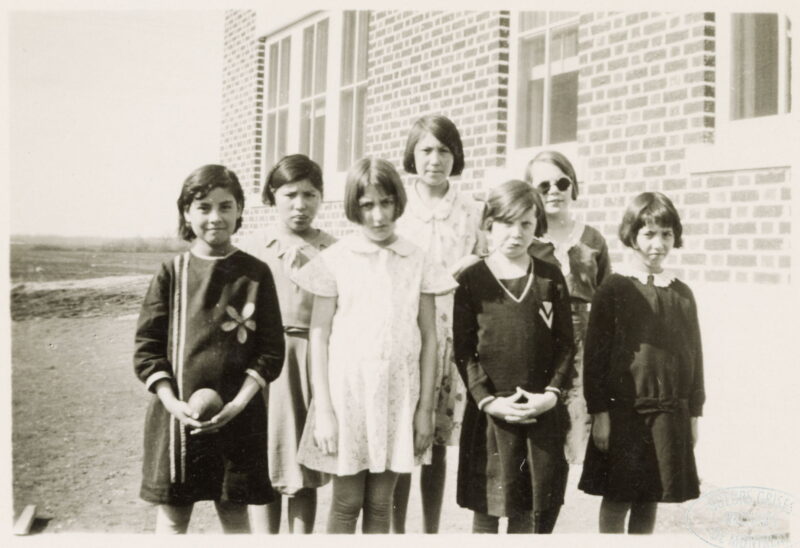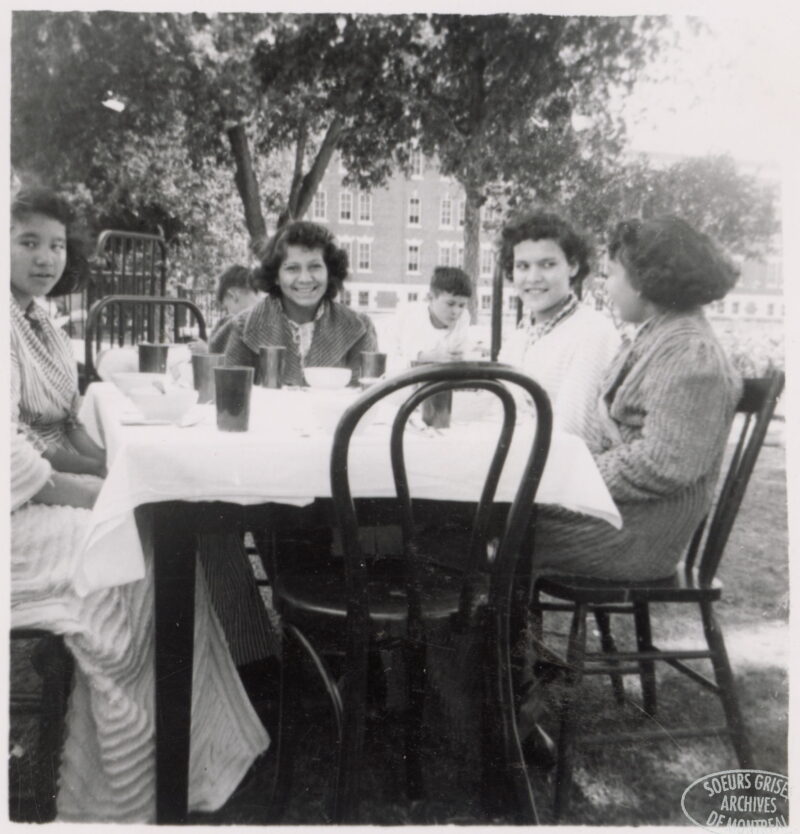St. Boniface Sanatorium
This page will be updated periodically as our research into records related to patients treated at St. Boniface Sanatorium continues.
The St. Boniface Sanatorium was founded in 1936 in a purpose-built building. Unlike the other TB treatment hospitals in the province, the St. Boniface Sanatorium (also known as the St. Vital Sanatorium) was run by the Grey Nuns of Montreal rather than the Sanatorium Board of Manitoba. The hospital accepted both Indigenous and non-Indigenous patients. In the historical records, it can sometimes be difficult to differentiate whether a patient was treated at the St. Boniface Sanatorium or the St. Boniface Hospital. These were two separate institutions in different parts of what is now Winnipeg, but both facilities were run by the Grey Nuns.
Where should I begin?
Before you begin your search, read our 'Where Do I Begin?' section of the website, including the Research Tips.
Depending on where your family or community member lived there are several “first stop” sources where researchers can begin. You may also find it helpful to come back to these sources if you have started somewhere else but hit a dead-end in your research.
Your research will take time. And maybe a lot of time, depending on how quickly various organizations respond your requests. Start the process of contacting them and requesting records as early as possible.
Before you contact the archives or records organizations, it is good to have some basic information handy, including:
- names, including any alternates (maiden names, step parent names, nicknames, etc.)
- where you think the person died or where they might be buried
- general time frame, especially an idea of when they may have passed away
(You can download our fillable pdf Research Checklist here)
This last piece of information is especially important for burial records, which sometimes contain personal health information (eg. the cause of death). In those cases, that record may be restricted and you may have to wait a certain amount of time after a person’s death to access the records. In Manitoba, death records become unrestricted 70 years after death at which point some of the information becomes available in the Manitoba Vital Statistics online database. See the Manitoba Vital Statistics section below for additional information.

Sept jeunes étudiantes à l'arrière du Préventorium (Seven young students at the back of the Preventorium), St. Boniface Sanatorium, Grey Nuns of Montreal, L098-22-25.2
1. The Records of the Sanatorium Board of Manitoba
The St. Boniface Sanatorium was not run by the Sanatorium Board of Manitoba, but the Central TB Registry that was maintained by the San Board contains information on patients treated at the St. Boniface Sanatorium. These records are held at the Archives of Manitoba and are restricted under the Manitoba Personal Health Information Act.
You can request that a search be performed in these restricted records, like the SBM Central Tuberculosis Register, to see if there is information about a specific patient. To request these records, fill out and submit a Personal Health Information (PHIA) request.
The PHIA request forms are not designed for historical record requests and the form may ask you to provide information or proof that is not available to you. That’s ok. Just fill in the information that you have and indicate how you are related to the patient in question. Please note that information requests for PHIA searches can only be made by the patient or a family member of the patient.
2. The Manitoba Vital Statistics Database
Many of the deaths that occurred at the Brandon Indian Sanatorium were recorded with Manitoba’s Vital Statistics Agency. If the death occurred more than 70 years ago, you can search for the person’s name in the Manitoba Vital Statistics online database. The database is updated every three months, so deaths that occurred between October and December of a year may not be added until sometime after January.
Using this database may be easier if you know a few tricks. You can also find an example of how the database can provide information related to burial sites in our Research Case Study: Manitoba Vital Statistics and Residential School Students.
Note: If you are looking for a family member who may have passed away less than 70 years ago, you can contact the Vital Statistics Agency and ask if you are able to request their death record. They may or may not be able to help in this situation, but you can ask.
3. The Nanilavut Initiative
If you are searching for information about an Inuit patient from the Inuvialuit Settlement Region you can request information from The Nanilavut Initiative. The Nanilavut Initiative was established after the Qikiqtani Truth Commission to help Inuvialuit and Inuit from across Canada locate lost loved ones who did not return home after being sent to southern hospitals during the Tuberculosis Epidemic (1940s to 1960s).
News story: In Pursuit of Resolution: Families continue to grieve loved ones who died of tuberculosis in the south (Nunavut News/North, 2017)
4. Government of the NWT: Medical Patient Search Project
If the person you are searching for came from the Northwest Territories, the Government of the Northwest Territories may be able to help you by searching records held by the NWT Archives.
During the last part of the twentieth century, the Government of the Northwest Territories launched a program to help families locate people who did not return following TB treatment. The NWT Government will attempt to help anyone whose family member was sent from the NWT to a southern hospital to locate information if they are able. Contact the NWT Archives here.
5. Manitoba Genealogical Society
The Manitoba Genealogical Society (MGS) has a wealth of cemetery transcriptions, and knowledgeable volunteers. Some of their resources are available online for free, but the best access is provided through purchasing a membership for a small fee.
Members and non-members can search the online Manitoba Name Index (MANI). You may need to try various spellings in your searches, but because many of the patients who died were not memorialized in a published obituary or with a headstone, the online databases may not be as helpful as some of the transcriptions the MGS holds in their collections but that are not included in the online databases. Only members can access the records that appear in the MANI database.
There are regional MGS sites across the province. If you cannot find what you need online and/or cannot attend a regional site, you can hire a volunteer to help you search through the MGS.
6. Library and Archives Canada
We will be adding more information about what is available through Library and Archives Canada (LAC) in the coming months. Broadly, LAC's collections include school files that may be helpful if the person you are looking for was a student at a residential school or sometimes a student at school located in a TB hospital. LAC also holds records of tuberculosis surveys and some hospital admissions. For young people who entered a sanatorium, family allowance records may also be helpful in your search.
Health records, family allowance files, and some school records will be restricted, but you may be able to make a request to see a particular record or records relating to yourself or a person who has passed away. The formal request procedure is explained online here.

Un groupe d'enfants attablées devant le Sanatorium en robe de chambre (a group of children sit at a table in front of the Sanatorium in their robes), St. Boniface Sanatorium, Grey Nuns of Montreal, L098-43.69
What sources can I consult that are specific to the St. Boniface Sanatorium?
1. Société historique de Saint-Boniface (St. Boniface Historical Society)
The Société historique de Saint-Boniface hosts some religious records, which may include burial records, relating to the St. Boniface Sanatorium. Researchers may have to get permission from the originating organization to access these records.
The website and research services are available in both French and English.
2. Grey Nuns of Montreal
The Grey Nuns of Montreal owned and operated the St. Boniface Sanatorium. The records of the Grey Nuns are housed at the Grey Nuns of Montreal Archive in Montreal. You can contact the Archive directly and ask them to perform a search for information about a missing patient.
3. Winnipeg Municipal Cemeteries Branch
The patient who you are looking for may have been buried in a Winnipeg Municipal Cemetery. We continue to do research on these cemeteries but know of patients who were buried in both St. Vital Cemetery and Brookside Cemetery. The city hosts online searchable databases for the municipal cemeteries.
The City of Winnipeg Municipal Cemeteries Branch holds the original burial registers for the municipal cemeteries. These burial records sometimes contain information not available in the online database. You can contact the Cemeteries Branch directly and request an Interment Search. There is a fee associated with this service, but if you note that you are searching for a missing Indigenous patient from the St. Boniface Sanatorium, they may waive the fee.
4. Other Hospitals
As already noted, it is sometimes difficult to decipher if a patient was in the St. Boniface Hospital or the St. Boniface Sanatorium. Patients could also move between the two and it is possible that patients may have been sent to a Winnipeg municipal hospital. You may want to make a PHIA request (see PHIA information above) for patient records if you think that the person you are looking may have died at one of these facilities.
Please note that information requests for PHIA searches can only be made by the patient or a family member of the patient.
5. Archdiocese of Winnipeg and Archdiocese of St. Boniface Catholic Archives
If the person you are looking for might have been Catholic, there is a small possibility that some of the records you are looking for might be at the Archdiocese of St. Boniface or the Archdiocese of Winnipeg.
6. Federal Voters Lists
The MITHP team has complied Federal Voters Lists for the St. Boniface Sanatorium for select years from 1949 through the 1960s. Voters lists for provincial or municipal elections are not included here.

